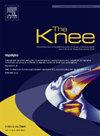Are joint line convergence angle and tibial slope related to bucket handle medial meniscal tear in chronic anterior cruciate ligament insufficiency?
IF 2
4区 医学
Q3 ORTHOPEDICS
引用次数: 0
Abstract
Background
This study aimed to assess the relationship between the joint line convergence angle (JLCA), posterior tibial slope (PTS), and anatomic medial proximal tibial angle (aMPTA) with bucket handle medial meniscus tears in patients with chronic anterior cruciate ligament (ACL) deficiency. It was hypothesized that increased joint obliquity and PTS might elevate the risk of such tears in chronic ACL insufficiency.
Methods
A total of 120 patients, who underwent primary ACL reconstruction surgery between 2012 and 2023 due to chronic ACL deficiency (ACL injury > 3 months) were retrospectively analyzed, except for those patients with isolated medial meniscal tear, isolated acute ACL injuries on primary MRI (without medial meniscus injury), combined ligamentous injuries (except for Grades 1–2 medial collateral ligament injuries), Grade 2–4 chondral injuries and lateral meniscal tears prior to the surgery on the same or opposite lower extremity. Their anatomic lateral distal femoral angle (aLDFA), aMPTA, JLCA, and PTS were measured using plain radiography and magnetic resonance imaging.
Results
Of the 120 patients, 75 (62.5 %) had bucket handle tears (Group 1), while 45 (37.5 %) did not (Group 2). Group 1 showed significantly higher JLCA, PTS, and aMPTA values than Group 2 (p = 0.004, p < 0.001, p < 0.001). No significant difference was observed in aLDFA (p = 0.131). Chronic ACL-deficient knees with joint obliquity had a 1.62 times greater risk of developing bucket handle tears.
Conclusion
JLCA, PTS, and MPTA are statistically significant predictors of bucket handle tear in the medial meniscus in knees with chronic ACL deficit.
Level of evidence: 3, retrospective cohort study.
慢性前交叉韧带不全患者的关节线会聚角和胫骨斜度是否与桶柄内侧半月板撕裂有关?
本研究旨在探讨慢性前交叉韧带(ACL)缺乏症患者关节线会聚角(JLCA)、胫骨后斜度(PTS)和解剖胫骨内侧近端角(aMPTA)与桶柄内侧半月板撕裂的关系。据推测,关节倾角和PTS的增加可能会增加慢性前交叉韧带不全患者发生撕裂的风险。方法回顾性分析2012 - 2023年间因慢性前交叉韧带缺陷(前交叉韧带损伤3个月)行原发性前交叉韧带重建手术的120例患者,除单纯内侧半月板撕裂、单纯急性前交叉韧带损伤(无内侧半月板损伤)、合并韧带损伤(1-2级内侧副韧带损伤除外)外,同一或对侧下肢手术前2-4级软骨损伤和外侧半月板撕裂。采用x线平片和磁共振成像测量解剖性股骨远端外侧角(aLDFA)、aMPTA、JLCA和PTS。结果120例患者中,75例(62.5%)有桶柄撕裂(1组),45例(37.5%)无桶柄撕裂(2组)。组1的JLCA、PTS和aMPTA值明显高于组2 (p = 0.004, p < 0.001, p < 0.001)。alfa无显著性差异(p = 0.131)。伴有关节倾斜的慢性acl缺乏的膝关节发生桶柄撕裂的风险是前者的1.62倍。结论jlca、PTS、MPTA对慢性前交叉韧带缺损膝内侧半月板桶柄撕裂有显著的预测意义。证据等级:3,回顾性队列研究。
本文章由计算机程序翻译,如有差异,请以英文原文为准。
求助全文
约1分钟内获得全文
求助全文
来源期刊

Knee
医学-外科
CiteScore
3.80
自引率
5.30%
发文量
171
审稿时长
6 months
期刊介绍:
The Knee is an international journal publishing studies on the clinical treatment and fundamental biomechanical characteristics of this joint. The aim of the journal is to provide a vehicle relevant to surgeons, biomedical engineers, imaging specialists, materials scientists, rehabilitation personnel and all those with an interest in the knee.
The topics covered include, but are not limited to:
• Anatomy, physiology, morphology and biochemistry;
• Biomechanical studies;
• Advances in the development of prosthetic, orthotic and augmentation devices;
• Imaging and diagnostic techniques;
• Pathology;
• Trauma;
• Surgery;
• Rehabilitation.
 求助内容:
求助内容: 应助结果提醒方式:
应助结果提醒方式:


